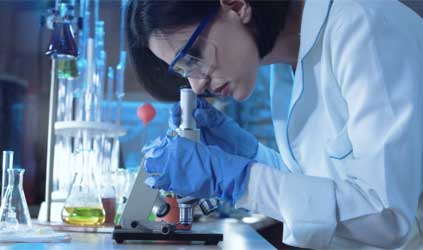May 30, 2016. Updated 8/17/2022
Steve Sabz

Galaxy Cluster SMACS 0723 from NASA's James Webb Space Telescope (cropped)
In his book titled, "A Universe from Nothing: Why There Is Something Rather Than Nothing" (2012), physicist Lawrence Krauss asserts that the stars were "kind enough to have exploded" in a sacrificial act akin to Jesus dying on the cross, saying, "I suppose that qualifies them as much as anything else for the role of saviors" (pg. 19). Dr. Krauss writes that the essential elements for life, such as carbon, nitrogen, oxygen, iron, were "made in the fiery cores of stars" (pg. 18).
How true are his statements? Should we, as Krauss asserts, "forget Jesus, [because] the stars died so that you could be here today" (video source, time 1:30, 2009), and attribute our existence to a dying star instead?
The first point we shall address are the ingredients that Krauss claims are created within the nuclear furnaces of stars. A star is predominately composed of hydrogen and helium. These two gases also happen to be the lightest elements of the 118 listed on the Periodic Table. Elements for life, such as carbon, nitrogen, and oxygen are thought to form via fusion reactions within the star. Heavier elements are likely formed when the star explodes in a violent event called a supernova. In this way, after many cycles of new and dying stars, we should end up with the 118 elements known today.
So far, Mr. Krauss' statement seems accurate. The 118 elements may have been created by stars, which later ejected their material into space after dying in a supernova explosion. In effect, we could be stardust. But what about the rest of his statement regarding "all the things that matter for evolution" (video source, time 1:20, 2009)? Were these "things" also created by stars?
The "things that matter for evolution" that Krauss must be referring to are the basic building blocks of life called amino acids. There are twenty amino acids, nine are essential (i.e., the body cannot produce them and must be obtained through the diet), and eleven are non-essential (i.e., the body produces them). These organic compounds bond together into long chains to form protein molecules. In turn, proteins are used extensively in the body to make everything from hair to enzymes.
Amino acids are synthesized from precursor molecules. The largest and most complex organic molecule found in interstellar space so far is iso-propyl cyanide (C4H7N). This is also the first organic molecule with a branched carbon backbone ever discovered and consists of twelve atoms. Even more, it was found at a vast 27,000 light-years from Earth (one light year equals a distance of 5,878,000,000,000 miles). Another organic molecule, dimethyl ether, was found in a planet-forming ring about 444 light-years from Earth. It consists of nine atoms. But neither of these function as precursor molecules for amino acids.
In May 2016, it was reported that glycine was detected "naturally vaporized" in space surrounding Comet 67P/Churyumov-Gerasimenko. This discovery is in addition to a previous finding in 2009, when glycine was detected in the gas and dust trail of Comet Wild 2. Glycine happens to be a non-essential amino acid that our bodies produce.
In December of 2020, the Japanese Hayabusa2 spacecraft returned to Earth with samples mined from the Ryugu asteroid, floating around in the main belt between Mars and Jupiter. Scientists detected glycine in addition to alanine, another non-essential amino acid.
These findings appear to support Krauss' secular world-view. However, in both cases, glycine consisted of a Carbon 13 isotope signature. The most abundant Carbon isotope found on Earth and in all living organisms is Carbon 12. Carbon 13 is extremely rare (1%) compared to Carbon 12 (99%). Astronomers were able to rule out contamination from Earth by identifying the Carbon 13 isotope of the glycine. We also know that only the simplest of amino acids, like glycine and alanine, are capable of forming in the freezing temperatures of outer space (the more complex amino acids require liquid water). This is similar to when, in 2014, scientists believed that comets brought water to Earth, but found that the water on comets consisted of the heavier deuterium, not the terrestrial H2O. This forced scientists to conclude that "this kind of comet could not have brought water to the Earth."
Just this year, astrobiologists detected nitriles in a molecular cloud near the center of our galaxy. Nitriles are organic molecules that serve as precursors for nucleobases (source). But these nitriles were found 26,673 light-years away from Earth, and the levels detected were measured to be "very low" and "rare." In addition, these nitriles are not precursors, but are the "building blocks of the building blocks of the building blocks" of life molecules. Not only that, Hugh Ross (Founder and Senior Scholar at Reasons to Believe) states that the scientists found them "in an interstellar molecular cloud where the chemical reactions that produce them are counterbalanced by chemical reactions that destroy them" (source).
The next pertinent question we need to answer is: Can extraterrestrial amino acids survive the extremely high temperatures encountered during entry through Earth's atmosphere?
A team of scientists encased glycine in ice to test its potential to survive entry aboard an icy comet. They also blasted the ice-encased glycine with proton beams to simulate atmospheric radiation. This experiment showed that "The ice offered some protection from the radiation-induced destruction of glycine that the researchers were going for." These results, combined with the fact that the Carbon 13 isotope of glycine is so rare on Earth (1%), show that terrestrial glycine is not likely to have been deposited from an Earth-bound comet.
In conclusion, the observable universe alone contains over 1 septillion stars, with 32 million supernovae explosions occurring per year. So far, we've found two non-essential amino acids that cannot survive entry through Earth's atmosphere. What is more, complex amino acids require liquid water to form, meaning they can only form on Earth. The two most complex molecules discovered don't qualify as precursors for amino acids. Finally, the barely detectable nitriles discovered are several steps removed from constituting building blocks for life. We may certainly find other "things that matter for evolution" in outer space. But this doesn't mean we can "forget Jesus", as Krauss suggests. Sure, some of the building blocks of life may in one form or another be derived from stars. However, dying stars cannot save us from our sins. Only a saving faith in the sacrificial death and triumphant resurrection of the Lord and Savior, Jesus the Christ, can atone for our iniquities and bring us into perfect union with our triune Creator, the only true God and Father of Jesus Christ, and his life-giving Holy Spirit.
CITE:
Sabz, S. (2016, May 30). Forget Jesus, the stars died for you. Retrieved from https://scienceandbibleresearch.com/forget-jesus-the-stars-died-for-you.html
Steve Sabz
Steve Sabz is the author and founder of Science and Bible Research. He is a professional educator with a Bachelor of Science degree in Exercise Physiology from William Paterson University, where he also completed graduate level courses in Human Physiology and Endocrinology. Steve has been studying theology since 2015 and has successfully completed seminary level courses in Textual Criticism, Biblical Hermeneutics, Eschatology, Puritan Theology, Ancient Church History, Soteriology, Biblical Theology, Prolegomena, and Biblical Greek from Puritan Reformed Theological Seminary, Southern Baptist Theological Seminary, and Dallas Theological Seminary. Steve is also the author of Evolution's Complexity Problem: See How Evolution Falls Apart At Its Beginning and End Time Rewind: An Exploration In Bible Prophecy And The Fate Of The World.






